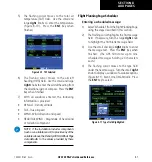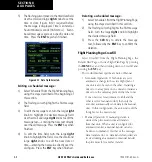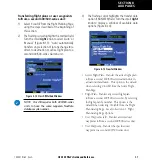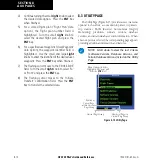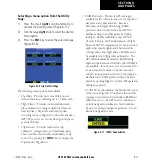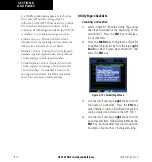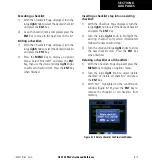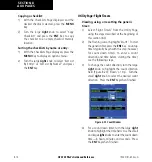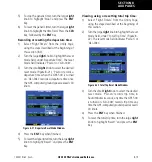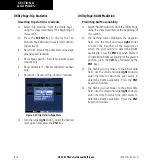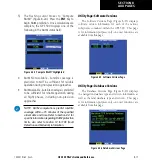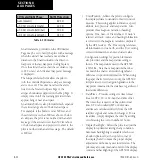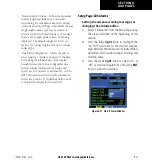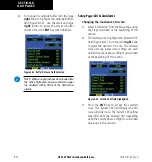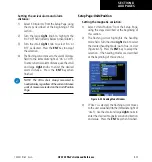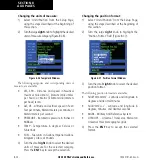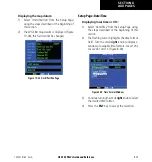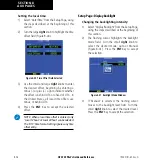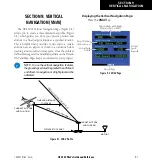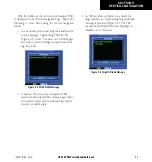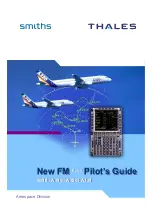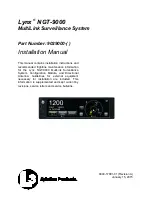
GPS 500 Pilot’s Guide and Reference
8-20
SECTION 8
AUX PAGES
CDI Scale/Flight Phase:
RAIM Protection:
Auto (oceanic)
4.0 nm
±
5.0 nm or Auto (enroute)
2.0 nm
±
1.0 nm or Auto (terminal)
1.0 nm
±
0.3 nm or Auto (approach)
0.3 nm
Table 8-2 CDI Scales
An arrival alarm, provided on the CDI/Alarms
Page, may be set to notify the pilot with a message
when the aircraft has reached a user-defined
distance to the final destination (the direct-to
waypoint or the last waypoint in a flight plan).
Once the aircraft has reached the set distance (up
to 99.9 units), an ‘Arrival at [waypoint]’ message
is displayed.
The Airspace Alarms fields allow the pilot to
turn the controlled/special-use airspace message
alerts on or off. This does not affect the alerts
listed on the Nearest Airspace Page or the
airspace boundaries depicted on the
Map Page. It
simply turns on/off the warning provided when
approaching or near an airspace.
An altitude buffer is also provided which ‘expands’
the vertical range above or below an airspace.
For example, if the buffer is set at 500 feet, and
the aircraft is more than 500 feet above or below
an airspace, the pilot is not notified with an alert
message; if the aircraft is less than 500 feet above
or below an airspace and projected to enter it, the
pilot is notified with an alert message. The default
is 200 feet.
• ‘Units/Position’ - Allows the pilot to configure
the displayed data to standard or metric units of
measure. This setting applies to distance, speed,
altitude, fuel, pressure, and temperature. Also
provides three
magnetic variation (heading)
options: True, Auto, or User-defined. If ‘Auto’ is
selected, all track, course and heading information
is corrected to the magnetic variation computed
by the GPS receiver. The ‘True’ setting references
all information to true north, and the ‘User’ setting
corrects information to an user-entered value.
Configuration settings for position format are
also provided, and the map datum setting is
shown. The map datum used in the GPS 500
is WGS 84. Note that a map datum that does
not match the charts can result in significant
differences in position information. When using
the paper charts for reference only, the GPS 500
still provides correct navigation guidance to the
waypoints contained in the database, regardless of
the datum differences.
• ‘Date/Time’ - Provides settings for time format
(local or UTC; 10- or 24-hour) and time offset.
The time offset is used to define current local
time. UTC (also called GMT or Zulu)
date
and time are calculated directly from the GPS
satellites’ signals and cannot be changed. To use
local time, simply designate the offset by adding
or subtracting the correct number of hours.
• ‘Display Backlight’ - Allows the pilot to adjust the
display for optimum viewing in any condition.
Automatic
backlighting is available which uses
a built-in photocell (at the top left corner of
the display bezel) to make the proper display
adjustments without any user intervention. The
pilot may also select manual control of the display
contrast and backlighting of the GPS 500’s display.
190-00181-60 Rev. G
Содержание GPS 500
Страница 1: ...GPS 500 Pilot s Guide and Reference ...
Страница 2: ......
Страница 72: ...GPS 500 Pilot s Guide and Reference 4 16 SECTION 4 FLIGHT PLANS Blank Page 190 00181 60 Rev G ...
Страница 98: ...GPS 500 Pilot s Guide and Reference SECTION 5 PROCEDURES 5 26 Blank Page 190 00181 60 Rev G ...
Страница 134: ...GPS 500 Pilot s Guide and Reference 7 12 SECTION 7 NRST PAGES Blank Page 190 00181 60 Rev G ...
Страница 240: ...GPS 500 Pilot s Guide and Reference SECTION 14 MESSAGES ABBREVIATIONS NAV TERMS 14 12 Blank Page 190 00181 60 Rev G ...
Страница 244: ...GPS 500 Pilot s Guide and Reference APPENDIX B SPECIFICATIONS B 2 Blank Page 190 00181 60 Rev G ...
Страница 255: ......


